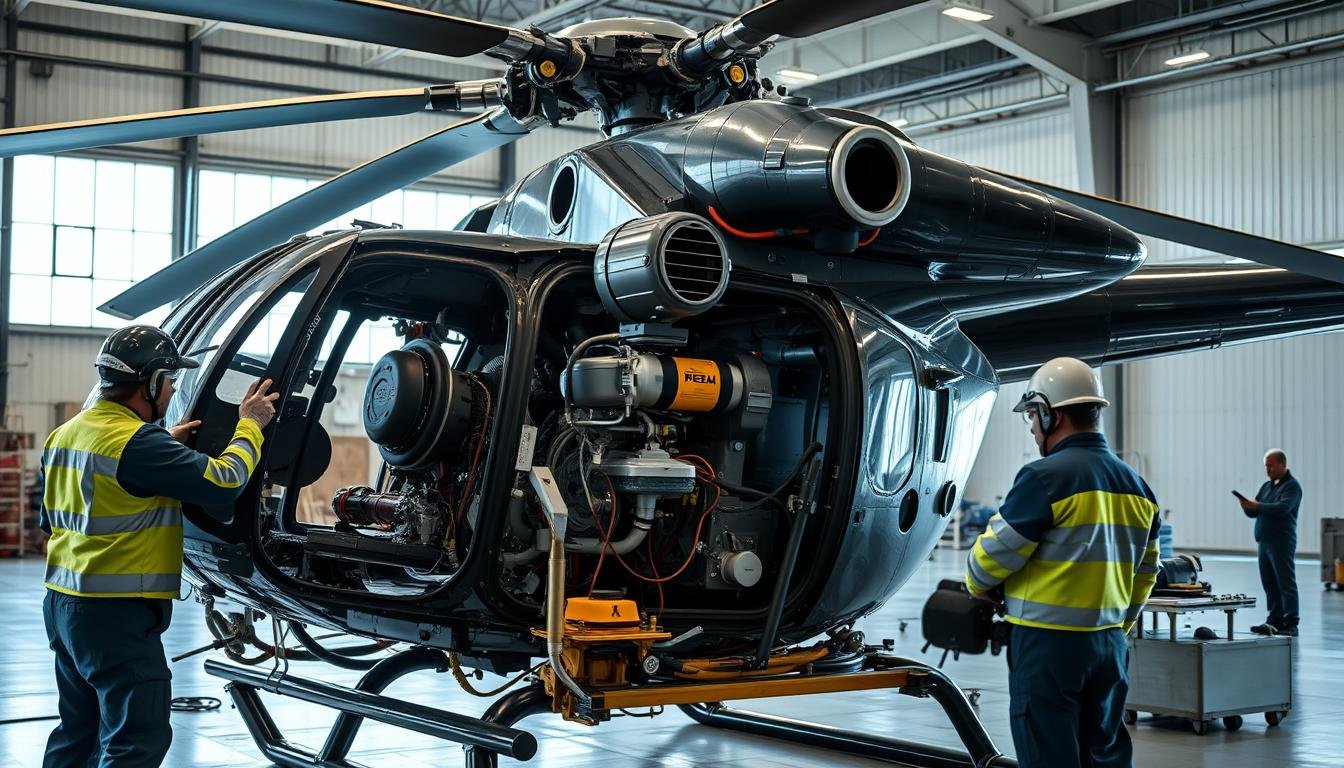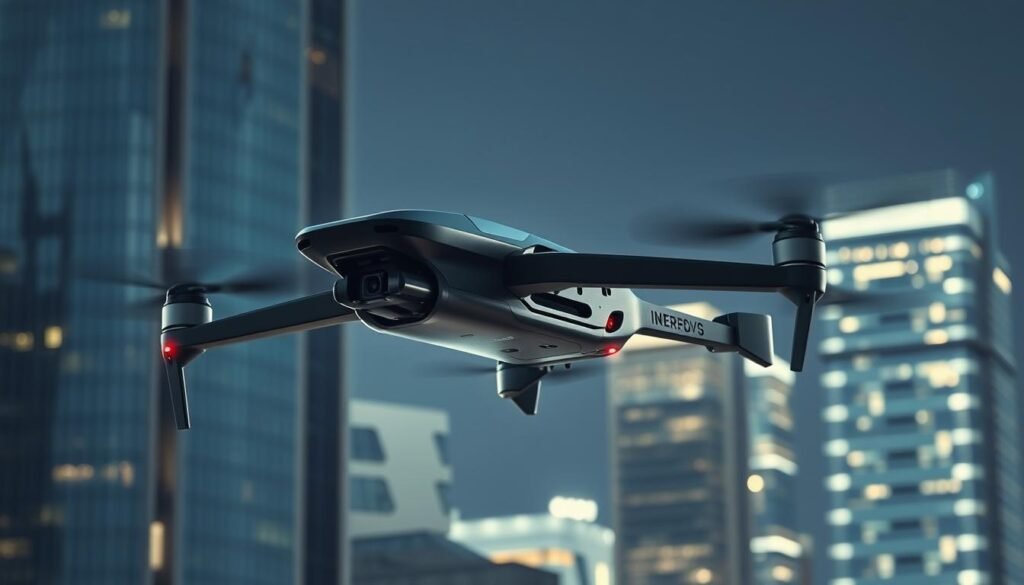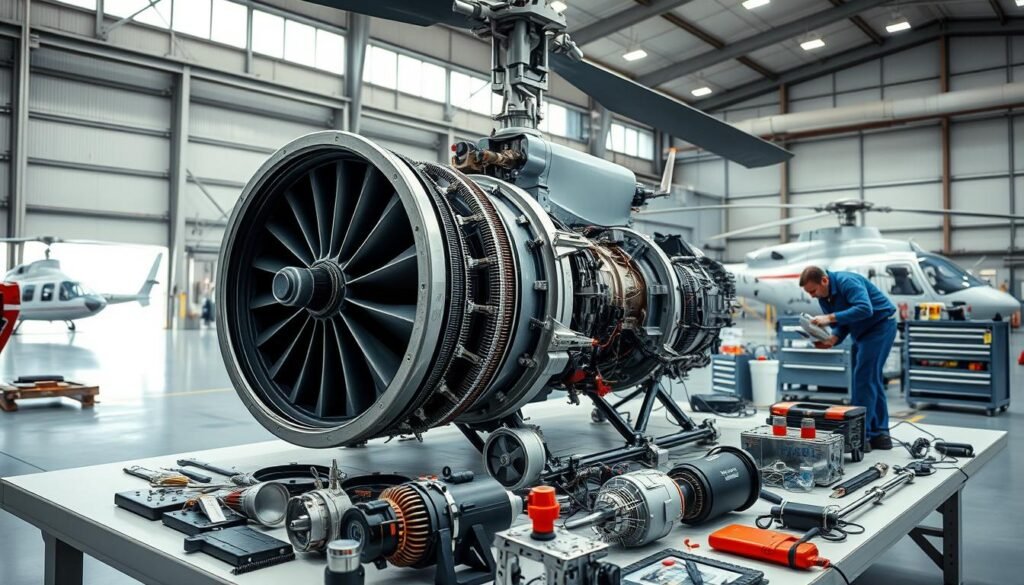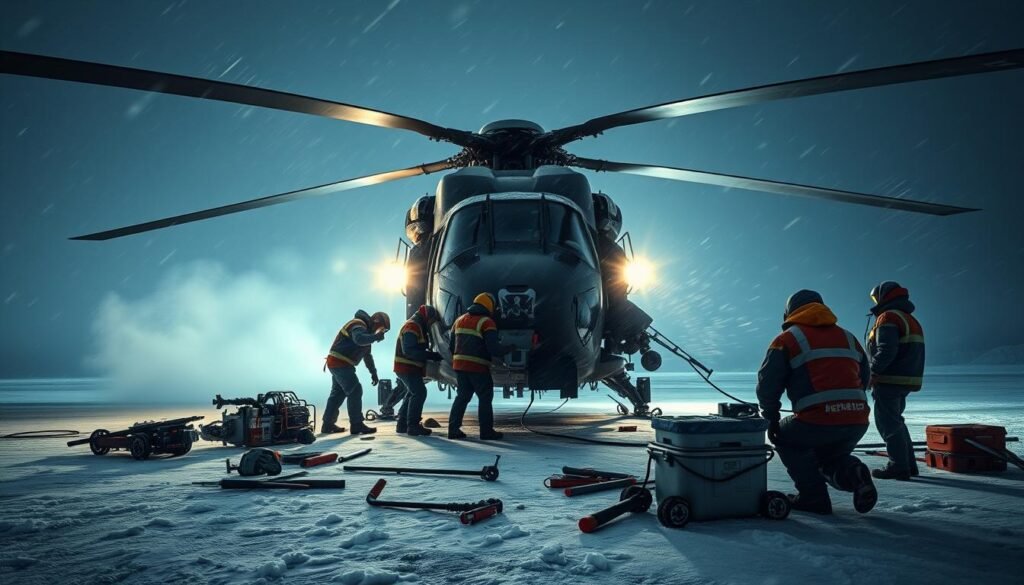One study found that rigorous upkeep cuts in‑service incidents by more than 40%. That scale of impact shows why operators must treat checks as non‑negotiable. Helicopter maintenance and flight safety is extremely important.
This section outlines how approved procedures, Service Bulletins, Airworthiness Directives, and tools like HUMS keep aircraft airworthy. AirbusWorld and global simulator centers back training. Regulators such as the FAA and programs like CAMP set predictable inspection cycles, including the 100‑hour rule for high‑use craft.
Insurers review records closely; detailed logs and compliance improve claim outcomes. The piece will show how to build a compliant schedule, execute system checks, and use digital logs and OEM guidance to reduce risks and downtime.
Readers will get actionable steps, checklists, and links to practical resources, including a routine checklist for pilots and operators: routine helicopter checklist.
Key Takeaways
- Proper upkeep significantly lowers incident rates and protects lives.
- Regulatory cycles like FAA inspections and CAMP create predictable care plans.
- Digital tools, HUMS, and OEM docs improve decision making and reduce human error.
- Insurer scrutiny rewards thorough records and scheduled work.
- Leadership commitment and training sustain a safety‑first culture.
Understanding The Stakes: Linking Maintenance To Flight Safety Outcomes
Operators who follow structured care programs see measurable drops in mechanical failures and incident rates.
This section shows a clear, how-to path. It ties practical tasks to measurable outcomes and regulatory compliance. Readers learn why missing an inspection window creates compounding risk and how to avoid that trap.
Decoding Search Intent: A Practical, How-To Path To Safer Helicopter Operations
Start with proven rules. FAA requirements, such as 100-hour inspections for high-use craft, prevent early-stage failures. Airbus groups work into three pillars: procedures, documentation, and training.
- Inspection windows: Missing one can let small faults grow into in-air issues.
- Management oversight: Standardized procedures cut variability in execution.
- Records: Poor logs invite denied claims and reduced resale value.
| Interval | Purpose | Key Outcome |
|---|---|---|
| Pre-Flight / Daily | Detect obvious defects | Immediate airworthiness check |
| 100-Hour / High Use | Early fault prevention | Baseline system health |
| Major Overhaul | Component life renewal | Long-term reliability |
The article will deliver checklists, scheduling methods, and verification steps tied to OEM manuals, service bulletins, and airworthiness directives. For practical pilot tips, see top 10 safety tips.
Helicopter Maintenance And Flight Safety: The Core Pillars That Prevent Failures
A program that fuses OEM procedures, records, and recurrent training stops small faults from escalating into emergency repairs.
Maintenance Procedures And Inspection Schedules That Meet Manufacturer And Regulatory Standards
Procedures are repeatable, verified steps drawn from OEM manuals that technicians execute to keep aircraft airworthy and aligned to standards.
Inspection schedules blend manufacturer intervals with regulatory checkpoints so wear and fatigue surface before they become in‑service failures.

Maintenance Documentation And Records Management That Stand Up In Audits And Claims
Records must be complete, legible, and organized. They prove conformity, support airworthiness decisions, and protect operators during audits or claims.
Centralized records tied to OEM updates ensure Service Bulletins and ADs are tracked, acted on quickly, and traceable for insurers.
Maintenance Training And Safety Culture Enabled By SMS And OEM Resources
Training is continuous. OEM curricula, e‑learning, and full‑flight simulators keep teams proficient.
SMS embeds hazard ID and proactive risk controls into daily work. HUMS turns vibration and usage data into actionable plans. Industry forums such as VAST and HeliOffshore accelerate team learning from real events.
For practical pre‑flight guidance, see pre-flight inspections.
How To Build A Compliant Maintenance Schedule That Reduces Risk
A robust schedule links regulatory obligations to everyday shop tasks so small defects are found before they escalate.
Aligning With FAA Requirements, 100-Hour Inspections, And CAMP For Ongoing Airworthiness
Start With Rules. Map FAA requirements and CAMP cycles to both calendar dates and usage hours. For heavily used aircraft, 100-hour inspections remain mandatory and must appear on the master plan.
Translating Line, A, B, C, And D Checks Into Daily, Weekly, And Annual Workflows
Translate commercial levels into practical blocks: line checks every 24–60 hours, A checks at 400–600 hours, B checks every 6–8 months, C checks planned as multi‑week events, and D checks budgeted years ahead.
- Assign tasks to daily teams for line items.
- Group A/B items into weekend packages to reduce downtime.
- Reserve parts and labor for C/D work with long‑lead planning.
Capturing Findings In Real-Time: Digital Logs, Airworthiness Directives, And Service Bulletins
Record At The Point Of Discovery. Use digital logs to link findings to SBs and ADs, trigger follow-ups, and show traceability for insurers.
Close The Loop. Set thresholds for deferral, define escalation paths for repeat defects, and feed recorded data back into interval planning to refine future schedules.

How To Execute Critical System Checks The Right Way
Well-executed system checks rely on OEM guidance, skilled technicians, and data from condition-monitoring tools.
Engine Health: Following OEM Intervals, Fluids, And Wear Limits To Prevent Power Loss
Follow OEM intervals for borescope inspections, filter swaps, and fluid analyses to protect engine margins. Use premium-grade fluids and record oil trends to spot early wear.
Plan adequate hours for these checks so work is not rushed. Assign qualified technicians for complex tasks.
Rotor Blades And Transmission: Inspection, Lubrication, And Damage Control To Avoid Catastrophic Failures
Inspect blades for cracks, erosion, and delamination. Log life limits, balancing data, and any approved repairs.
Maintain transmissions with scheduled lubrication and contamination checks to prevent latent damage.

Avionics And Electrical Systems: Certified Updates, Calibrations, And Compliance With Navigational Standards
Keep avionics software and databases current with certified updates. Verify calibrations after any change to navigation or comms systems.
Using HUMS, Tools, And SOPs: Data-Driven Decisions And Proper Equipment For Safe Maintenance
Leverage HUMS trend data to schedule targeted checks and avoid unplanned removals. Apply SOPs with calibrated tools and approved equipment every time.
“Document every inspection and corrective action with clear references to OEM procedures.”
Documenting work ensures traceability for insurers and auditors and helps plan future inspections and repairs.
How To Integrate Safety Management, Training, And Risk Financing
Integrating a formal safety program with training pipelines and insurer-ready records closes the loop between risk controls and operational readiness.
The goal is a single process that captures hazards, trains staff, and proves compliance to underwriters.
Airbus programs, VAST, and HeliOffshore provide proven practices for hazard ID, human factors, and standardized procedures. These elements feed an SMS that spans hangar work to helipad ops.
Embedding SMS, HFDM, And VAST/HeliOffshore Practices With OEM Training And Full-Flight Simulators
Combine data with training. Integrate HFDM and HUMS trend lines into the SMS to trigger mitigations and validate fixes.
Build a training pipeline with OEM-aligned courses and full-flight simulators for recurrent and mission-specific drills. Airbus supports this approach through global centers and OEM data packages.
Linking Proper Maintenance And Records To Insurance Readiness And Reliable Coverage
Documented processes matter to insurers. Prime Insurance highlights that high-quality records and SB/AD compliance improve claim outcomes and coverage reliability.
Use a clear claim-support process: maintenance histories, calibrated equipment certificates, and corrective-action logs. That creates trust with underwriters and lowers financial risk.

| Area | Practical Step | Benefit | Who Leads |
|---|---|---|---|
| SMS Integration | Embed HFDM alerts and HUMS trends | Faster hazard closure, fewer surprises | Safety Manager |
| Training Pipeline | OEM courses + FFS recurrent sessions | Higher competency, consistent responses | Training Dept. |
| Insurance Readiness | Complete records, SB/AD proof, calibration logs | Better coverage terms, claim support | Technical Records |
“Demonstrable processes and objective competency checks turn policyholders into preferred risks.”
Prioritize resources using risk-based scoring. Attend industry conferences to adopt proven innovations and keep the program current.
Final Thoughts
Consistent checks, timely parts, and trained teams keep systems performing under real operational demands.
Disciplined maintenance programs that match CAMP levels with manufacturer guidance ensure the right inspections occur at the right time with qualified technicians and adequate hours. This reduces minor issues before they escalate to costly repairs or damage.
Clear records prove compliance, speed audits, and support claims. Use HUMS, SMS, and OEM training to turn data into daily decisions and to lower uncertainty when operators must show proof to insurers.
Collaborate through VAST, HeliOffshore, and OEM forums, then review schedules, verify parts and documentation, update procedures today to improve outcomes. For common misconceptions and helpful context see top myths about rotorcraft safety.
FAQ
What are the core pillars that prevent failures in rotorcraft upkeep?
The core pillars include scheduled inspections, adherence to manufacturer procedures, qualified technicians, and robust records. Regular checks of engines, rotor systems, transmissions, and avionics reduce wear and detect damage early. A documented process that follows OEM manuals, FAA or EASA rules, and company standard operating procedures ensures tasks occur at the right intervals and to the right standard.
How does a compliant inspection schedule reduce operational risk?
A compliant schedule aligns with regulatory intervals such as 100-hour checks, CAMP or equivalent programs, and OEM service bulletin timelines. Translating line, A, B, C, and D checks into daily, weekly, and annual workflows keeps airworthiness current. Real-time findings capture through digital logs and timely corrective action minimizes in-service failures.
What role do technicians and training play in preventing in-flight issues?
Skilled mechanics and avionics technicians following OEM training and recurrent courses spot subtle defects and perform precise repairs. Safety culture, supported by a Safety Management System (SMS) and human factors training, encourages reporting of defects before they escalate. Using certified tools and approved data preserves component integrity and compliance.
Which critical systems require the most frequent attention to avoid catastrophic events?
Engine health, rotor blades, main transmission, and flight control linkages demand frequent attention. Monitoring fluid condition, wear limits, blade erosion, and torque signatures helps identify impending failures. Health and Usage Monitoring Systems (HUMS) and routine vibration analysis provide data-driven alerts for timely intervention.
How should operators manage maintenance documentation for audits and insurance?
Maintain complete, chronological records of inspections, repairs, parts installed, and AD/SB compliance in an auditable digital system. Include technician signatures, work orders, and return-to-service approvals. Clear records link maintenance practices to insurance readiness and support liability claims or warranty actions.
What is the best practice for handling airworthiness directives and service bulletins?
Review ADs and service bulletins upon issue, assess applicability, and schedule corrective actions into the maintenance plan. Track compliance dates in the maintenance management system and document completed work with serial numbers and part references. Prioritize ADs that impact flight-critical systems.
How do HUMS and condition monitoring improve decision-making?
HUMS gathers vibration, temperature, and usage data to detect anomalies earlier than visual inspections. Condition monitoring enables predictive maintenance—replacing parts based on condition rather than fixed hours—reducing unscheduled downtime and lowering lifecycle costs while improving reliability.
What procedures ensure safe avionics updates and electrical work?
Avionics and electrical work must follow certified installation procedures, use approved parts, and include post-installation calibration and functional checks. Technicians should reference type-specific wiring diagrams, software release notes, and RTCA/DO standards where applicable. Log all software versions and calibration certificates.
How can operators embed SMS and HFDM practices into maintenance culture?
Integrate an SMS that defines reporting lines, risk assessment processes, and corrective action workflows. Combine Flight Data Monitoring (HFDM) with maintenance data to identify systemic issues. Train crews and maintenance personnel on hazard recognition, encourage nonpunitive reporting, and use trend analysis to prioritize interventions.
What are practical steps to align line and base maintenance tasks with OEM guidance?
Map OEM task cards to company workflows, designate responsibilities for line vs. base tasks, and set clear intervals for inspections and component replacements. Use checklists derived from the manufacturer’s manual and maintain parts and tooling lists to ensure consistent, compliant work. prevent mechanical failures and reduce the risk of accidents. Proper maintenance is not just about keeping the helicopter in the air—it’s about ensuring that every flight is as safe as possible for both the pilot and passengers.
Related Articles
- How to Avoid Common Helicopter Pilot Errors: A Guide to Safe Flying
- The Role of Air Traffic Control in Helicopter Safety
- Helicopter Safety in Bad Weather: Tips for Flying in Adverse Conditions
- How to Safely Land a Helicopter in Challenging Conditions
- The Importance of Proper Helicopter Maintenance for Flight Safety
More from This Category
- Understanding Helicopter Weight and Balance: Why It’s Crucial for Safe Flying
- Emergency Procedures in Helicopter Flights: How to Handle In-Flight Incidents
- Helicopter Pre-Flight Inspections: What Pilots Must Check Before Takeoff
- How to Prepare for Your First Helicopter Ride: Safety Procedures for Passengers
- Top 10 Helicopter Safety Tips Every Pilot Should Know



